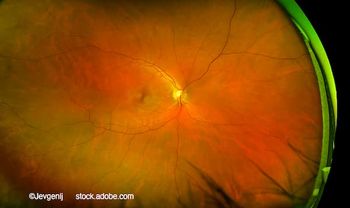
Mild corticosteroids may reduce Sjögren’s inflammation
A mild topical corticosteroid may be effective in treating the symptoms of Sjögren’s disease without causing the adverse effects associated with higher-dose steroids. Findings from a pilot study also suggest that ocular surface metrology is useful in evaluating the effects of the steroid.
Reviewed by Ranjini Kottaiyan, OD, MBA
Take-home message: A mild topical corticosteroid may be effective in treating the symptoms of Sjögren’s disease without causing the adverse effects associated with higher-dose steroids. Findings from a pilot study also suggest that ocular surface metrology is useful in evaluating the effects of the steroid.
Rochester, NY-A mild topical corticosteroid could be effective in treating the symptoms of Sjögren’s syndrome by reducing the inflammatory tear cytokines and the rate of evaporation, suggest findings from a small pilot study.
Visit:
Ocular surface metrology performed with tools-such as wavefront sensing and thermal imaging-appear to be effective in analyzing the effects of treatment, said Ranjini Kottaiyan, OD, MBA, lead researcher, Ocular Surface Laboratory, Flaum Eye Institute, University of Rochester, Rochester, NY.
Corticosteroids have been used to treat dry eye symptoms of Sjögren’s syndrome. However, the risk of adverse effects, such as increased IOP and cataract formation after prolonged use, has prompted interest in a lower strength steroid, such as loteprednol etabonate ophthalmic suspension 0.5% (Lotemax, Bausch + Lomb).
Related:
Loteprednol was administered QID for 2 weeks in this study, which enrolled 10 subjects (20 eyes) with Sjögren’s syndrome.
Cytokines hard to detect
According to Dr. Kottaiyan, it appears all cytokines are not easily detectable in all patients. For example, IL-17 was detected in 13% of patients in one study. TNFa was detected in only 2% of patients in one study and 12% in another (LaFrance et al., Curr Eye Res. 2008;33:525-544. doi: 10.1080/02713680802190085; Enriquez-de-Salamanca et al., Mol Vis. 2010 May 19;16:862-873.).
Recent:
“The goal of the study was to evaluate tear cytokines before and after a treatment regimen, and we chose people with Sjögren’s syndrome because they have inflammatory mediators in their eyes,” Dr. Kottaiyan outlined. “The unique thing about this study is that we utilized our ocular metrology in conjunction with tear analysis to noninvasively and objectively study tear parameters. We compared the objective measures to the presence of inflammatory mediators in the eye after treatment.”
Editorial:
At baseline, Dr. Kottaiyan and colleagues recorded clinical characteristics, such as Schirmer’s test results, tear break-up time, entrance and exit IOP, osmolarity, and corneal staining. They also used a custom-built Shack-Hartmann wavefront sensor, which measured visual quality changes caused by aberrations in tear film dynamics, and a thermal camera (Thermovision A40, FLIR Systems) to assess ocular surface temperature.
All measurements were taken in a controlled environmental chamber, a 12- × 12-foot room in which the temperature, humidity, and airflow could be controlled precisely.
Related:
The subjects were asked to present for 3 weekly visits. After baseline measurements were taken at the first visit, loteprednol was administered, and then measurements were taken again 30 minutes later with the wavefront sensor and thermal imaging to evaluate the drug’s short-term effect. Tears were collected by two techniques, with and without a saline wash.
“We found that with the saline wash, the data was highly variable, and did not show trends across the sampling time points,” Dr. Kottaiyan said. “So we published data just from native tear collection.”
Testing conditions
Ranjini Kottaiyan, OD, and colleagues measured visual quality changes caused by aberrations in tear film dynamics, and a thermal camera to assess ocular surface temperature. All measurements were taken in a controlled environmental chamber, which the temperature, humidity, and airflow could be controlled precisely. (Photo courtesy of Ranjini Kottaiyan, OD)The subjects were then directed to use the steroid QID for the remainder of the study. At the first and second visits, patients were tested in nominal environmental conditions in which the temperature was about 75° F and relative humidity 45%.
Practice Management:
The subjects were then directed to use the steroid QID for the remainder of the study. At the first and second visits, patients were tested in nominal environmental conditions in which the temperature was about 75° F and relative humidity 45%.
In the final visit, the subjects were tested as soon as they arrived and again after spending 30 minutes under stressed environmental conditions (temperature 80° F, relative humidity 20%).
Changes in visual quality and ocular surface temperature were observed throughout the study. During the first visit, testing of the short-term effect showed that 30 minutes after instillation of the steroid, the visual quality worsened and the average ocular surface temperature increased.
This trend was not significant but was indicative of reduced surface evaporation, Dr. Kottaiyan said.
Editorial:
However, long-term effects were more apparent.
“The ocular surface temperature significantly increased at 2 weeks after treatment (p = 0.02),” Dr. Kottaiyan said. “This shows that this is a good way to objectively measure how the ocular surface responds.”
Normal, stressed conditions
The researchers also compared the subjects based on their responses under normal and stressed environmental conditions.
“In the stressed environment, we found that the ocular surface temperature increases but visual quality decreases,” Dr. Kottaiyan said.
The study also included Luminex analysis of tear cytokines. Only 6 of 9 tear samples collected could be evaluated due to low tear-volume collection.
“We chose people with severe form of dry eye, so it was very challenging to collect tears from them,” Dr. Kottaiyan said.
The results showed that at least 6 cytokines were elevated in the study population before treatment, and all of them were reduced after loteprednol treatment at 2 weeks. In at least 3 of the 9 patients, all 6 of the cytokines were reduced, while concentrations of some, but not all cytokines, were lower in other subjects.
This analysis could be considered a pilot study that will help researchers refine the technique for tear analysis. The ocular surface metrology, using the wavefront sensing, thermal imaging, combined cytokine analysis, is equally important, Dr. Kottaiyan said.
“We can extend this technique to a bigger study where we can study cytokines in other types of dry eye patients and perform ocular surface metrology to study dry eye in other treatments to see how the disease progresses,” Dr. Kottaiyan added. “We observed that thermal imaging and wavefront-sensing techniques were very effective.”
More:
Ranjini Kottaiyan, OD, MBA
This article was adapted from Dr. Kottaiyan’s poster presentation at the 2015 meeting of the Association for Research in Vision and Ophthalmology. The researchers received grant support from Research to Prevent Blindness and Bausch + Lomb.
Newsletter
Don’t miss out—get Ophthalmology Times updates on the latest clinical advancements and expert interviews, straight to your inbox.



















































.png)


